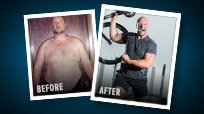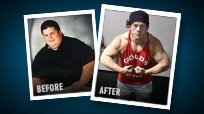Here's a fitness riddle for you: If you achieve a dramatic physical transformation, and there isn't an equally dramatic "before-and-after" photo series to document it, did it even happen?
Of course it did. But given how common the transformation photo has become in marketing campaigns and social media, it would be perfectly acceptable if you didn't want to share it. After all, why put yourself at risk of someone giving you the ultimate insult: "Total Photoshop!"
Maybe you've made that comment, or at least "liked" it. That's understandable, because the notion that you can use technology to fudge a transformation is getting more common all the time. BuzzFeed Blue recently fed into this with a video and Facebook post titled "How to Fake a Before and After Picture."
How To Fake A Before & After Photo
Let's set aside for a moment the fact that the lighting tricks didn't do much in that video, since the people only ended up slightly more defined than before. Let's not dwell on why a few random thin people felt qualified to use the label "total bullshit" for a motivational tool that has helped millions.
Let's just ask the question: Can a real transformation be faked?
The answer can be summed up in two words: No way. I know, because I've been there—on both sides of the camera. I've photographed the results of major transformations, and I've been one of them.
THE POWER OF A SMILE
It was the winter of 1999 when I had my "aha" moment. I'd gone from an active athlete in college to an office desk-jockey with a million and one excuses for why I "couldn't" work out. I was busy. Too tired. I had too much work. Blah, blah, blah. Riding a sugar wave through the day—6-8 cans of Mountain Dew on a regular basis—and constantly grazing on office treats didn't help matters. Growing disgusted with my expanding waistline and jeans that would no longer fit, I realized I had to make a change.
A friend recommended a book called "Body for Life" by Bill Phillips. It piqued my interest, and I checked out the book's website. Featured on the site were a number of people with their before-and-after photos. They were similar to the ones on TV commercials—the same ones I thought were totally faked to sell a product.
One woman stood out among the others on the site. She was from Omaha, Nebraska, where I was living at the time, and I thought, "No way! A woman from Omaha did this?" Her name was Kelly Adair, and she was the winner of the 1998 EAS Physique Transformation contest. She had a "before" photo taken in her backyard, and an "after" photo in a professional studio.
Try as I might to maintain my skepticism, something about Kelly's smile caught my attention. Obviously she had changed physically, but far more impressive was the undeniable energy she exuded in the "after" photo. She was glowing with confidence. I wanted to experience that feeling again.
I bought the book, read it from front to back in a day, and committed to doing the 12-week challenge. And I'm glad I did, because it changed my life forever. After just three months, I felt better, looked better, and was far happier. I was damn proud of what I'd done, and just like Kelly had, I wanted to document it with a great "after" photo.
You've earned your "after"
My transformation took place over 15 years ago, but aside from changes in clothes and haircuts, the basic elements of "before" and "after" photos haven't changed much. "Before" is often poorly lit in someone's home or backyard. You'll typically see the person slumped down with their shoulders rolled forward and stomach hanging out. Maybe they'll even have disheveled hair and a frowny face.
The "after" photo is typically taken by a professional photographer like me. You'll definitely see better lighting than in the "before" photo. This is to be expected, because—newsflash—photographers know the ins and outs of lighting for photography. The person will likely have their hair groomed, stand with better posture, and maybe have a tan. They'll likely be grinning from ear to ear and beaming a totally different energy than in their "before" photo.
Do these things help a photo? Absolutely. Are they necessary? No, but if you've ever worked at something for months, struggled against temptation, and put in the grueling work necessary to see a dramatic change, you want to showcase it in the best possible way. After all you've gone through, you've earned it.
If you've lost a significant amount of weight, or even just enough to make you feel like a different person, you deserve to glam up and show off a little. You feel triumphant and special, and deserve to hold something in your hands that makes you tear up and say, "Wow" every time you look at it. You deserve to have the new you immortalized.
This would be true even if nobody was ever going to see your photo. However, it's especially true if you want your photos to inspire you to stay the course—or to inspire someone else to change theirs.
GET BEHIND THE PHOTO
You don't have to dig too deep into Bodybuilding.com or BodySpace to find transformation photos that boggle the mind and seem to stretch credulity. This is because when you inevitably imagine yourself in that "before" situation, you aren't sure you have what it takes to make the long, painful, difficult, hungry, exhausted journey to "after." But you won't know until you try.
Do "before" and "after" pictures make that journey seem shorter and simpler than it is? Of course. But the best of them also make clear just how utterly life-changing a transformation truly is—particularly after you read the incredible stories that go along with them, and which appear all the time on Bodybuilding.com.
The truth is, you can't fake a true fitness transformation. You can't "light" your way to lasting weight loss. You can't trick your way out of making a commitment, sticking to a healthier lifestyle, and transforming for the long haul.
Just ask Pat Ryan, who's lost over 100 pounds. Or Kelsey Byers, who inspired thousands in 2012 by dropping 40 pounds and overhauling her lifestyle. Or the people featured in this transformation video, or any of the incredible people whose stories are shared weekly on Bodybuilding.com. They know that a real transformation goes far beyond what any photo could ever capture.
Bodybuilding.com Transformation Commercial
The next time you see someone's "before" and "after" photos, don't be so quick to post something negative, or assume that technology made a big difference. Instead, if you want to change, take a look at yourself. You can do it. Use "before" and "after" photos to motivate you. If you need even more incentive, join a free transformation challenge and make a change with an entire community.
Whatever you do, don't look for an excuse. Look for action, and support those who take it. Doing so changed my life, and it can certainly change yours.

Recommended For You

Body Transformation: Pat, The Body Fat Killer
Pat completely turned his life around and obliterated 30% of his body fat.
Body Transformation: A Model Transformation
Kelsey's wake-up call was seeing a 175 staring back at her from the scale. First, she cleaned up her diet. Then, she lost the weight.


Join The Conversation! @Buzzfeed we believe you #CantFakeFit thousands of lives changed @bodybuildingcom https://bbcom.me/1uI4igT #bodybuildingcom